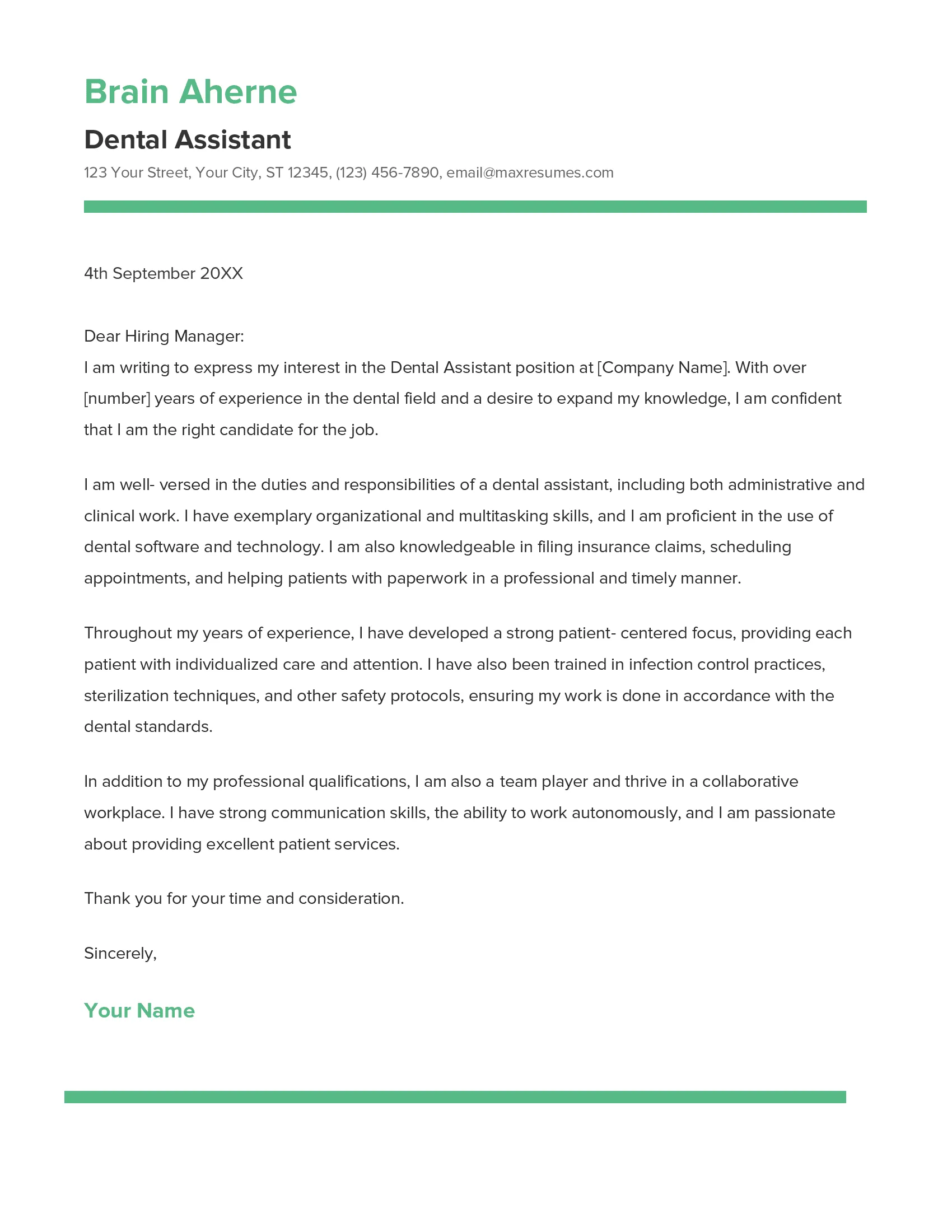Understanding the Purpose of a Dental Assistant Cover Letter
A dental assistant cover letter serves as your initial introduction to a potential employer, providing a crucial opportunity to showcase your personality, skills, and experience beyond your resume. It’s your chance to make a positive first impression and demonstrate why you’re the ideal candidate for the dental assistant position. This document isn’t merely a formality; it’s a vital tool in the job application process. It helps you stand out from other applicants and allows you to explain how your qualifications specifically align with the job requirements and the dental practice’s needs. A well-crafted cover letter can significantly increase your chances of getting an interview and ultimately landing the job.
Why a Cover Letter Matters for Dental Assistants
In the competitive field of dental assisting, a cover letter is essential. It allows you to articulate your passion for dentistry and highlight your relevant skills in a way that a resume alone cannot. It provides the space to elaborate on your experiences, such as assisting with various dental procedures, managing patient care, and handling administrative tasks. The cover letter enables you to personalize your application by tailoring it to the specific requirements of the dental practice. It also lets you demonstrate your written communication skills, an important aspect of professional interactions. By effectively conveying your qualifications and enthusiasm, your cover letter increases your chances of securing an interview and ultimately, the job. A strong cover letter separates you from the crowd and demonstrates your dedication to becoming a dental assistant.
Highlighting Your Skills and Experience
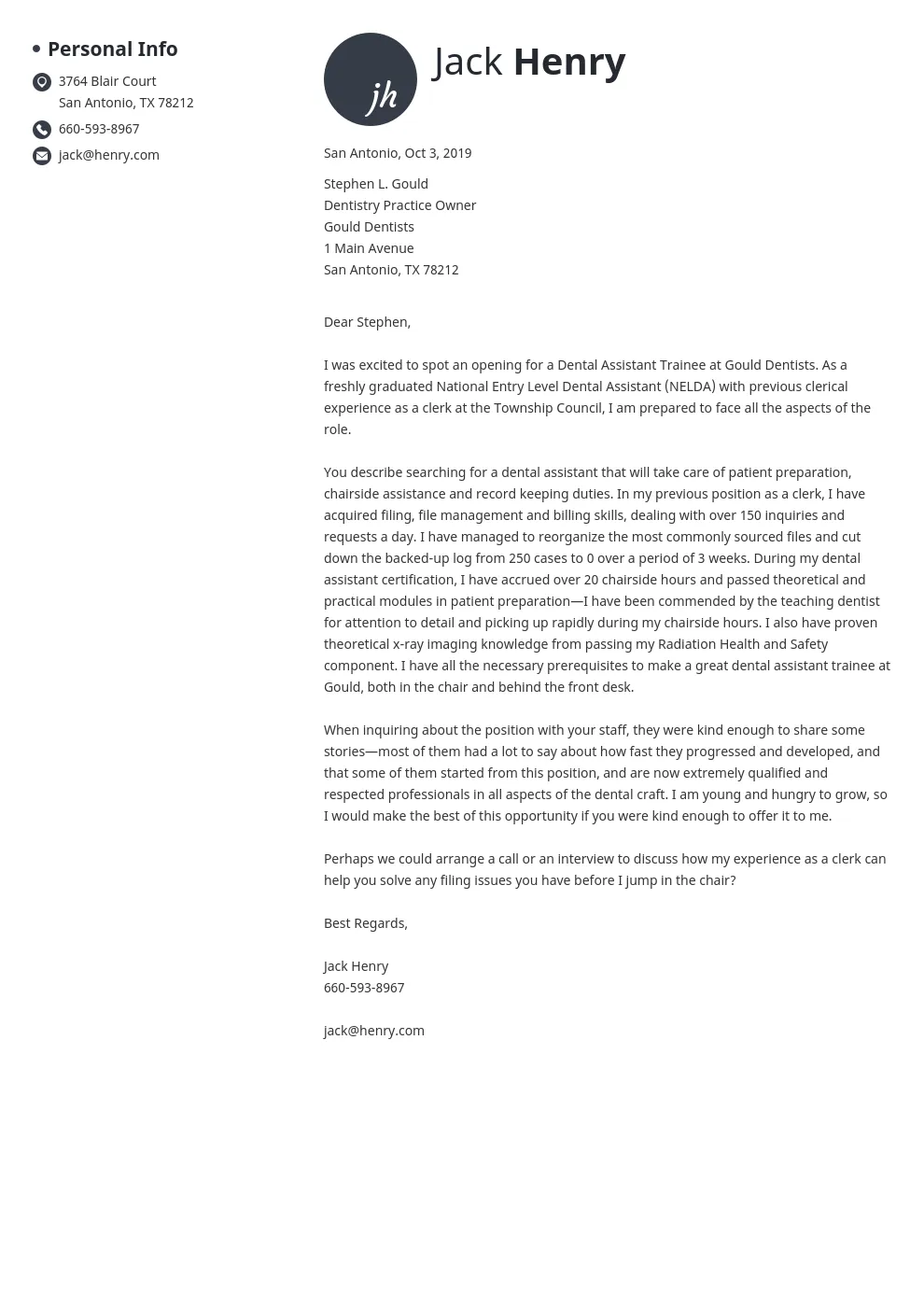
Your cover letter is the perfect space to highlight your key skills and experiences relevant to the dental assistant role. Start by identifying the core skills emphasized in the job description. This could include patient care, sterilization protocols, assisting with procedures, taking x-rays, or managing dental records. Provide specific examples of how you have utilized these skills in previous roles. For instance, detail your experience in assisting with dental fillings, crown placements, or root canals. Quantify your achievements whenever possible; for example, mention the number of patients you assisted daily or any efficiency improvements you implemented. Make sure to align your skills with the practice’s needs, showcasing your ability to contribute to their team and the overall success of the dental practice. Consider mentioning any specific software or equipment you’re proficient with, such as dental practice management software or digital radiography systems. The goal is to create a clear, compelling narrative that showcases your value as a dental assistant.
Essential Components of a Dental Assistant Cover Letter
Contact Information and Salutation
Begin your cover letter by including your contact information in the header. This should include your full name, phone number, email address, and optionally, your LinkedIn profile URL. Ensure the information is accurate and up-to-date. Following the contact information, address the recipient with a professional salutation. Ideally, address the letter to a specific person (e.g., Dr. Smith, Hiring Manager). If you cannot find a name, use a professional greeting such as “Dear Hiring Manager.” Avoid generic salutations like “To Whom It May Concern.” Personalizing the salutation shows you have researched the practice and are committed to the opportunity. Use professional language and formatting to make a positive first impression. Proper formatting and addressing show that you are attentive to details.
Opening Paragraph Strategies
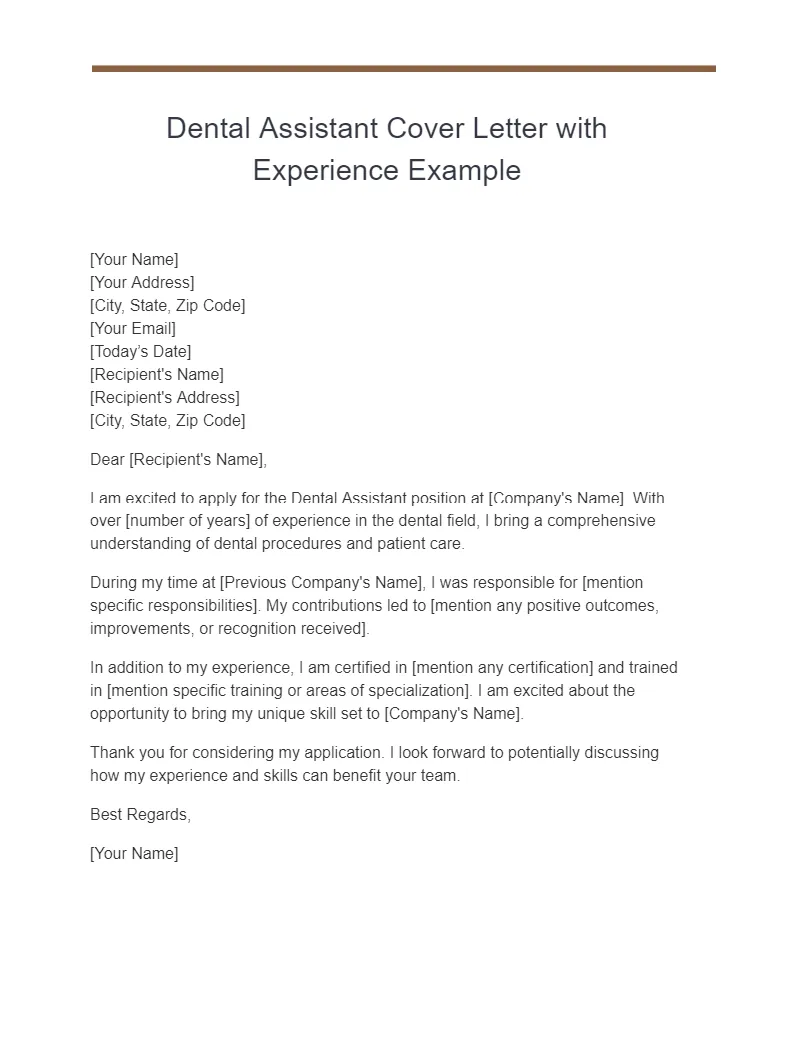
The opening paragraph sets the tone for your cover letter and should immediately capture the reader’s attention. Clearly state the position you are applying for and where you found the job posting. Briefly mention your strongest qualifications or a key skill that aligns with the job requirements to make an impact. For example, you might state, “I am writing to express my keen interest in the Dental Assistant position at [Dental Practice Name], as advertised on [Platform]. With [Number] years of experience in assisting with various dental procedures and a strong focus on patient care, I am confident in my ability to contribute to your team’s success.” This opening should be concise, enthusiastic, and highlight your relevant experience. Your goal is to make the reader want to read on to learn more about your qualifications and why you are a good fit.
Body Paragraphs Emphasizing Skills
The body paragraphs are the core of your cover letter, where you demonstrate how your skills and experience align with the job requirements. Dedicate each paragraph to a specific skill or area of experience, providing detailed examples of your accomplishments. Use the STAR method (Situation, Task, Action, Result) to structure your responses and provide a clear picture of your capabilities. In your first paragraph, you might discuss your clinical skills, describing your experience with chairside assisting, taking X-rays, and preparing instruments. The second paragraph could focus on your interpersonal skills and patient care abilities, showcasing your ability to create a comfortable environment for patients. In addition, quantify your achievements wherever possible, like the number of patients assisted or any improvements you’ve implemented. Be specific and relevant to the dental practice’s needs. This shows you have the skills and knowledge to excel in the position.
Showcasing Clinical Skills
When detailing your clinical skills, focus on experiences that align with the job description’s requirements. For example, if the job requires experience with endodontic procedures, mention your experience in assisting with root canals, preparing the operatory, and sterilizing instruments. Detail your experience in taking digital X-rays, creating accurate images, and ensuring patient safety. If you have experience with specific software or equipment, be sure to mention that, such as experience with CEREC or other advanced dental technology. You might state, “In my previous role, I assisted with an average of [Number] root canal procedures per month, ensuring proper patient preparation and maintaining a sterile environment.” Provide examples that demonstrate your skills in assisting with various dental procedures, such as fillings, crowns, and implants. Make sure to demonstrate your ability to maintain a clean and organized workspace. Highlighting your clinical skills gives the employer confidence in your abilities.
Highlighting Soft Skills
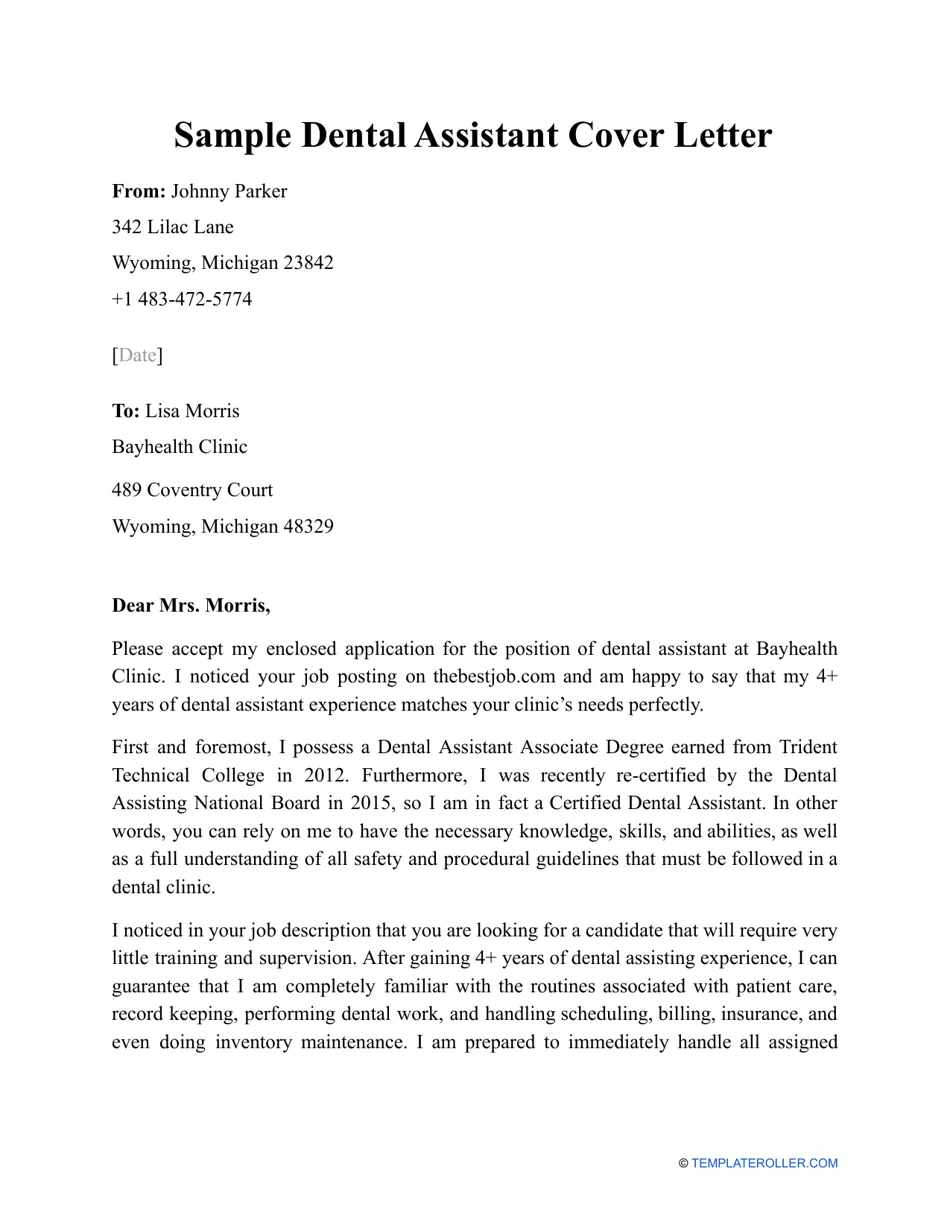
Soft skills are crucial for success as a dental assistant, and you should dedicate space in your cover letter to highlight them. Emphasize your communication skills, as you will be communicating with patients, dentists, and other staff. Highlight your patient care abilities and experience with comforting and calming anxious patients. Mention your teamwork skills and your ability to collaborate effectively with other members of the dental team. Include examples of your problem-solving skills; show how you handle unexpected situations or efficiently address patient concerns. Your organizational and time management skills are equally important; demonstrate your ability to manage multiple tasks, prioritize responsibilities, and ensure the smooth flow of appointments. Examples could include resolving patient conflicts, improving appointment scheduling, or collaborating with the team to ensure efficient workflows. This demonstrates your ability to contribute to a positive and productive work environment.
Addressing the Employer’s Needs
To make your cover letter truly compelling, align your qualifications with the specific needs of the employer. Carefully review the job description and identify the key requirements and the practice’s values. Tailor your letter to address these specific needs. For example, if the job description emphasizes a focus on patient comfort, provide examples of how you create a welcoming and stress-free environment for patients. If the practice prides itself on its use of advanced technology, highlight your experience with specific dental software or equipment. When mentioning your skills, describe how they will benefit the practice. For instance, state how your experience in efficient sterilization techniques will help maintain a safe and organized environment. Show how your skills contribute to the dental practice’s goals. This personalized approach will make your application stand out and demonstrate your dedication to the position and the dental practice.
Closing the Cover Letter
Your closing paragraph should reiterate your interest in the position and summarize your key qualifications. Express your enthusiasm for the opportunity to contribute to the practice. Restate your key strengths and their relevance to the employer’s needs. You can also mention your willingness to discuss your qualifications in more detail during an interview. Express gratitude for the reader’s time and consideration. Make sure your closing paragraph leaves a positive and lasting impression, encouraging the employer to contact you. A strong closing reinforces your interest and leaves the door open for the next step in the hiring process.
Call to Action and Professional Closing
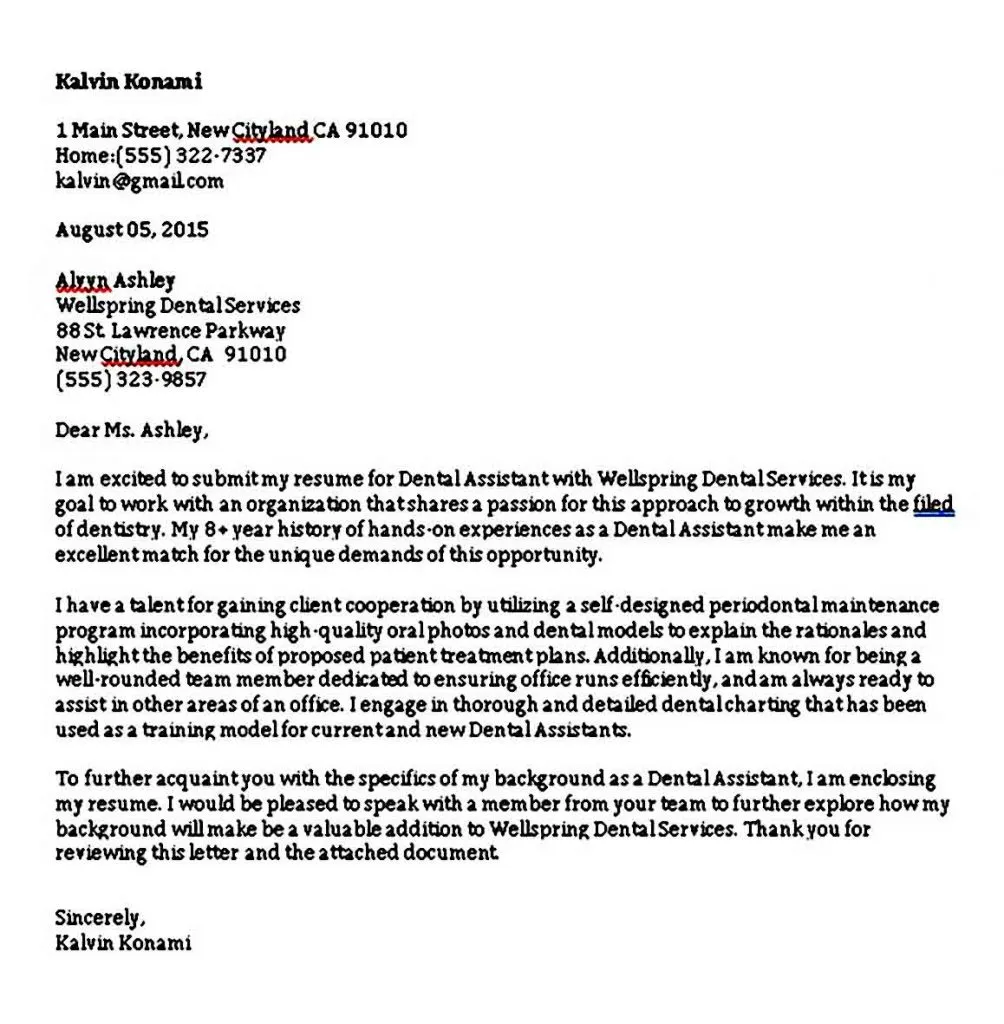
Conclude your cover letter with a clear call to action and a professional closing. Clearly state your availability for an interview and provide your contact information again to make it easy for the employer to reach you. Use a professional closing, such as “Sincerely,” “Best regards,” or “Thank you for your consideration.” Avoid informal closings. After your closing, leave space for your signature if you are submitting a physical copy. If you are sending an electronic cover letter, your typed name will suffice. Thank the employer for their time and consideration. This formal closing will ensure that you end the cover letter on a positive and professional note. A strong call to action shows that you are eager for the next step in the application process.
Tailoring Your Cover Letter for Specific Jobs
Researching the Dental Practice
Before writing your cover letter, thoroughly research the dental practice you are applying to. Visit their website, read online reviews, and check their social media presence. Learn about their services, values, and any specific technologies or techniques they use. If possible, try to identify the dentist or hiring manager’s name. Researching the practice provides valuable insights that will help you tailor your cover letter to their specific needs. For example, if the practice specializes in cosmetic dentistry, highlight your experience in assisting with cosmetic procedures. If the practice has a focus on patient comfort and technology, mention your skills in those areas. By demonstrating your knowledge of the practice, you show that you have taken the time to learn about them and are genuinely interested in the role.
Customizing Your Letter for Each Application
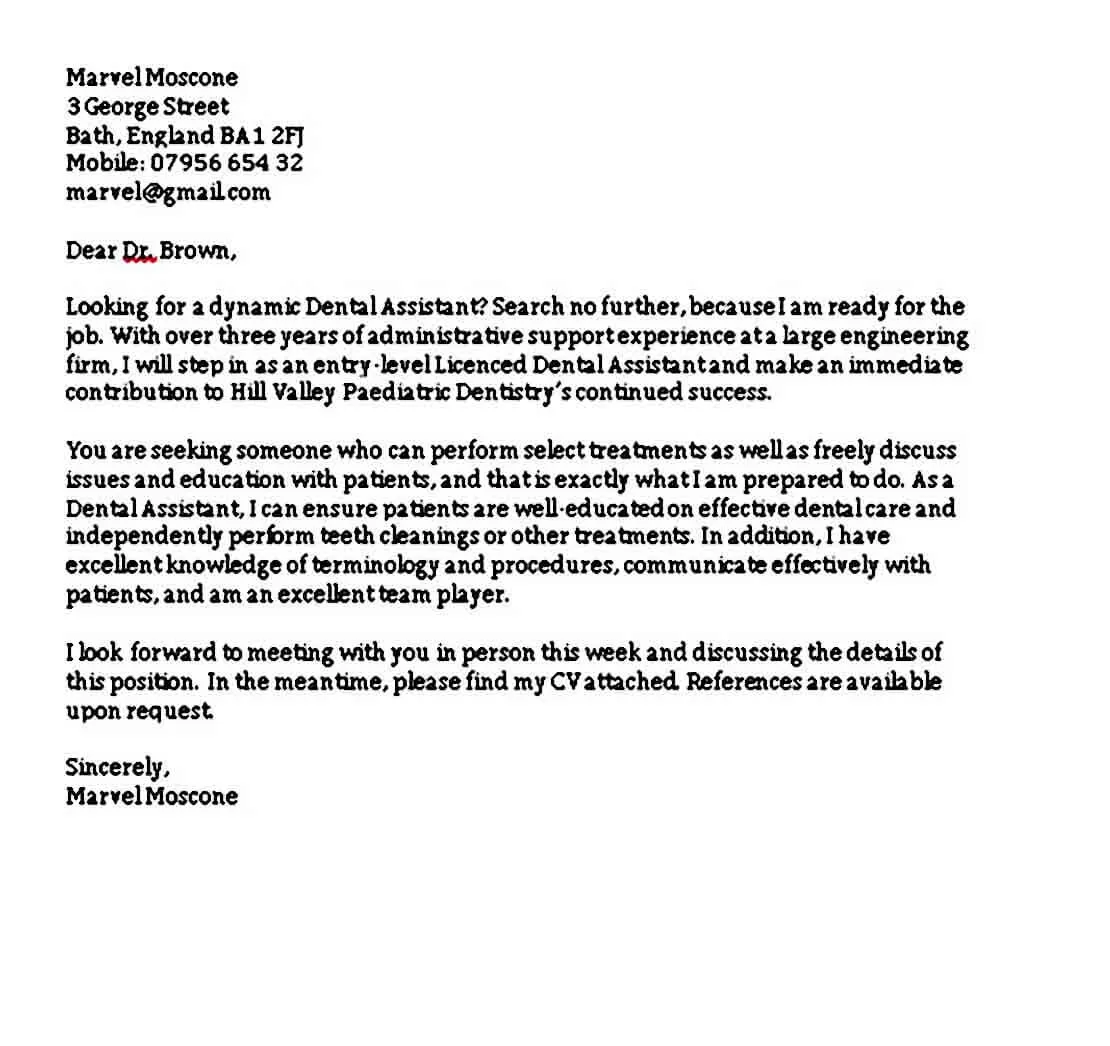
Avoid using a generic cover letter for every application. Customizing your cover letter for each job is important. Review the job description carefully and identify the key requirements and preferences. Then, modify your cover letter to address those specific needs. Tailor your opening paragraph to mention the position and dental practice directly. Highlight your relevant skills and experience, providing examples that align with the specific job duties. Consider using keywords from the job description throughout your letter to demonstrate your understanding of the role. By personalizing your letter, you show that you are genuinely interested in the position and have taken the time to understand the employer’s needs. This approach increases your chances of getting an interview. A customized cover letter shows that you are a serious candidate. Ensure your letter reflects the dental practice’s specific values.
Formatting and Proofreading Your Cover Letter
Choosing the Right Font and Format
The formatting of your cover letter is just as important as the content. Select a professional, easy-to-read font, such as Times New Roman, Arial, or Calibri, with a font size between 10 and 12 points. Maintain a clean and organized layout. Use standard one-inch margins on all sides. Align the text to the left and avoid using a justified alignment, as this can create uneven spacing between words. Use single-spacing within paragraphs and double-spacing between paragraphs. Include clear headings and subheadings to break up the text and make it easier to read. If you are submitting an electronic cover letter, save the document as a PDF to ensure that the formatting is preserved across different devices. Remember, the goal is to create a visually appealing document. Make sure the format is easy to read.
Proofreading for Errors and Clarity
Proofreading your cover letter is critical to ensure that it is free of errors and reflects your professionalism. Read the letter multiple times, carefully checking for grammatical errors, spelling mistakes, and typos. Use a grammar checker to identify any potential issues. Check for clarity and ensure that your sentences are well-structured and easy to understand. Ask a friend, family member, or career counselor to review your cover letter for feedback and suggestions. A fresh pair of eyes can often catch errors you might have missed. Make sure your tone is professional and appropriate for the dental profession. Before submitting your letter, verify that all contact information is accurate. Proper proofreading will show that you pay attention to detail and have excellent communication skills. A polished cover letter boosts your credibility.
Common Mistakes to Avoid in a Dental Assistant Cover Letter
Ignoring the Job Description
One of the most common mistakes when writing a cover letter is failing to address the specific requirements of the job description. Many applicants submit generic letters that do not reflect the specific needs of the dental practice or the responsibilities of the position. Carefully review the job description and tailor your letter to highlight the skills and experiences that are most relevant. Use keywords from the job description in your letter to demonstrate your understanding of the role. Make sure you address all the key qualifications and responsibilities listed. Failing to customize your letter shows a lack of attention to detail and a lack of interest in the position. It is critical to show you understand what the dental practice is looking for.
Generic Cover Letters
Submitting a generic cover letter is a major mistake. Employers can quickly identify generic letters that are not tailored to their specific practice. These letters lack personalization and fail to showcase your specific skills and experiences in a way that resonates with the employer. Take the time to research the dental practice and customize your letter to address their unique needs and values. Highlight your relevant skills and provide specific examples of your accomplishments. Demonstrate that you understand the practice’s mission and that you are enthusiastic about the opportunity. Generic letters will not get you noticed, because they do not express your genuine interest in the specific opportunity. Show that you want to work at that particular dental practice.
Overusing Jargon
Avoid using excessive dental jargon in your cover letter. While it is important to demonstrate your knowledge of dental terminology, overusing technical terms can make your letter difficult to understand and may come across as pretentious. Use clear and concise language. Explain your skills and experiences in a way that the hiring manager can easily understand, even if they are not a dental professional. Focus on conveying your abilities, rather than trying to impress the reader with technical terms. Write your letter in a professional and understandable tone, and ensure that your descriptions are easy to follow. Using too much jargon can make the reader feel excluded, which can prevent you from securing an interview. It’s important to show you are capable of effectively communicating.
Additional Tips for a Strong Cover Letter
Showcasing Your Passion for Dentistry
Expressing your passion for dentistry can significantly boost your cover letter and make you a more compelling candidate. Share why you are drawn to this field and what motivates you to pursue a career as a dental assistant. You might mention specific aspects of dentistry that you find interesting, such as helping patients achieve healthy smiles or the opportunity to work with advanced technologies. Include examples of your involvement in related activities, like volunteering in dental clinics or participating in continuing education courses. Demonstrate your commitment to staying updated with industry trends and advancements. Your passion should be genuine and authentic. This will show the employer that you are dedicated to your career. Highlighting your enthusiasm will make you stand out.
Mentioning Relevant Certifications
Include all relevant certifications and licenses in your cover letter. List your certifications, such as the Certified Dental Assistant (CDA) or other specialized certifications, as they are required in the job posting. Specify your certifications. If you are a registered dental assistant (RDA), make sure to indicate that clearly. Mention any specific training or courses you have completed, such as certifications in coronal polishing, or CPR/First Aid. When listing certifications, include the name of the certification, the issuing organization, and the date of completion. This gives the employer confidence in your qualifications. Making sure your certifications are up to date is key to your application.
Including References
Consider including a sentence in your cover letter stating that references are available upon request, especially if the job posting requests this. This will reassure the employer that they can verify your qualifications and experiences. Have references ready to provide when needed, including previous supervisors, dentists, or colleagues who can speak to your skills and work ethic. Ensure that your references are aware that they might be contacted by the employer. Provide your references with a copy of your resume and cover letter so they can accurately discuss your qualifications. If you are not including a list of references in your cover letter, make sure to have a separate reference list prepared and readily available.
